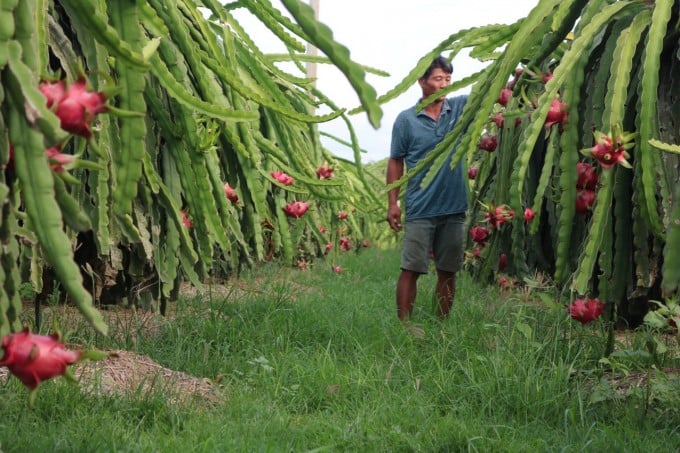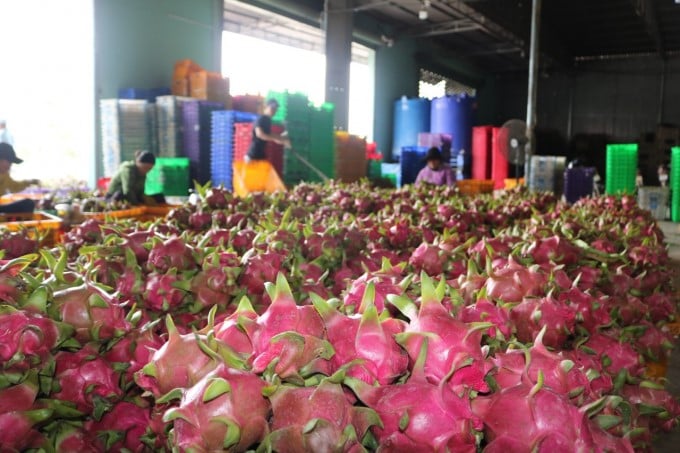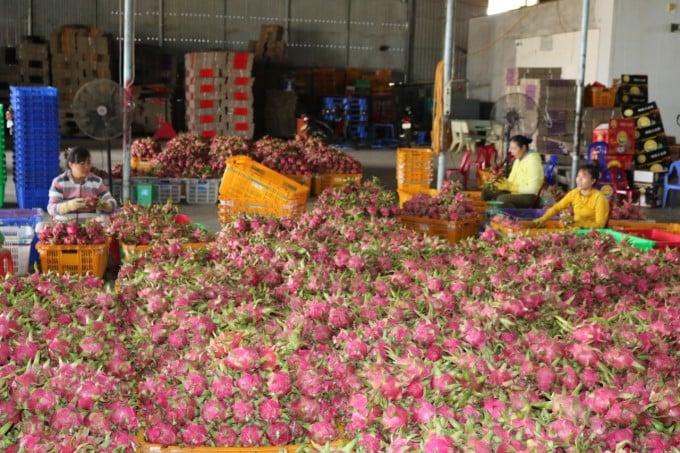November 28, 2025 | 02:55 GMT +7
November 28, 2025 | 02:55 GMT +7
Hotline: 0913.378.918
November 28, 2025 | 02:55 GMT +7
Hotline: 0913.378.918

Binh Thuan province has determined that dragon fruit is the main local crop. Photo: KS.
Binh Thuan is the "capital" of dragon fruit in the country with an area of up to 33,750 hectares, of which the harvesting area is 30,886 hectares, the output is 698,029 tons, mainly concentrated in Ham Thuan Nam, Ham Thuan Bac, and Bac Binh districts.
According to Binh Thuan Department of Agriculture and Rural Development (DARD), the province has about 10,500 ha of dragon fruit certified with VietGAP, accounting for 31.1% of the total area, and nearly 355 ha of dragon fruit granted the GlobalGAP Certificate.
Total revenue of white-fleshed dragon fruit in the area on average per year is VND 420-430 million /ha, 4-5 times higher than other fruits (rambutan, banana, pomelo), 7 - 8 times higher than growing rubber (VND 30 million / ton), 20 times higher than growing cashew, 8 times higher than growing rice. After deducting costs, on average, with 1 ha of dragon fruit, farmers make a profit of VND 175 - 180 million (due to the large garden depreciation expense).
Mr. Phan Van Tan, Deputy Director of Binh Thuan DARD, has judged that the development of dragon fruit in the area in recent times in the area has not been sustainable and commensurate with its potential.
In terms of production, although it has established an association group, cooperative group, cooperatives, and cooperative union to produce dragon fruit, it is still lacking in both quantity and quality.
In terms of processing, although the harvest area is very large, there are not many facilities in the province for dragon fruit products’ deep processing. The processing output is estimated at less than 10%.

Currently, Binh Thuan dragon fruit has not developed sustainably, having unstable output and price. Photo: LK.
Furthermore, production has not been closely linked with consumption, so the output market has not been stable and sustainable. Some grower gardens have not strongly applied dragon fruit production according to high standards and technology, and have not strictly followed the use of pesticides.
In order to develop dragon fruit sustainably in near future, Binh Thuan's agriculture industry will deploy solutions towards intensive farming, increase productivity and improve quality, meeting the food sanitary and safety requirements to serve domestic use and export.

Binh Thuan's agricultural sector will promote solutions to improve the quality of dragon fruit in response to domestic and export markets. Photo: KS.
Accordingly, Binh Thuan DARD will promote advocacy and propaganda activities to people about the meaning and importance of dragon fruit production according to VietGAP standards; synchronously deploying from production stage to packaging, preliminary processing and preservation facilities to actively serve exportation.
Moreover, they will prioritize investment in research and transfer of science and technology in the production and processing of dragon fruit, and at the same time gradually develop dragon fruit production in the direction of GlobalGAP to expand the market; research and develop new dragon fruit varieties to replace degraded ones to diversify products and improve dragon fruit’s productivity, quality and economic efficiency; promote the transfer of technical advances, especially high-tech production models, and replicate effective models to reduce production costs, improve competitiveness to develop dragon fruit sustainably.
According to Mr. Tan, in addition to the mentioned solutions, the province will step up measures to support the promotion of the dragon fruit consumption market in the direction of properly considering the importance of domestic markets, strengthen the expansion of cooperation relations, develop distribution channels with localities throughout the country, especially the Ho Chi Minh City and Hanoi markets, and in the meantime, diversifying and expanding export markets to other countries, in which the Chinese market is still the regular market, mainly increasing official export and facilitating cross-border exports at the same time.
Additionally, the province will encourage the development of the dragon fruit processing industry and support enterprises to invest in factories to process all kinds of products and goods from dragon fruits such as dried dragon fruit, limber-dried dragon fruit; producing dragon fruit juices, dragon fruit wine; making cakes, jams, candies,... in order to reduce the pressure of fresh fruit consumption stage...

(VAN) According to Mr. Vo Minh Thanh, Director of the Tay Ninh Department of Agriculture and Environment, Resolution 57 has created a new development pathway for the locality, shifting from traditional toward modern agriculture.
/2025/11/26/4909-2-154329_878.jpg)
(VAN) Pearl grouper farming in HDPE cages not only delivers economic efficiency but also contributes to protecting the environment, creating jobs, and promoting marine-based experiential tourism.

(VAN) The model of making a living under the forest canopy through the agroforestry system in Van Son commune, Bac Ninh province, is expected to generate an annual income of approximately VND 30 million/ha.

(VAN) Many enterprises in Can Tho are harnessing natural energy and reducing greenhouse gas emissions in their production processes, thereby contributing to the promotion of a sustainable green transition.
/2025/11/24/3536-2-112800_176.jpg)
(VAN) Dong Nai now has tens of thousands of hectares of forests certified for sustainable management, and this area will continue to be expanded in the coming period.

(VAN) Vinh Ha hamlet (Dai Xuyen commune, Hanoi) is shifting away from small-scale farming as households adopt bioscurity into their breeder chicken models.

(VAN) Heavy rains make aquatic species more vulnerable to disease. Proactive water management and high-tech systems help farmers prevent outbreaks and protect yields.